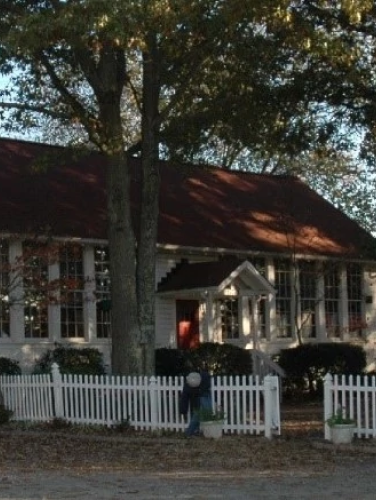
Caldwell Station School
(ca. 1880s)
The Caldwell Station School represents the gradual and often disjointed post-Civil War rebuilding of the North Carolina public education system.
17616 Caldwell Station School Road, Huntersville, NC 28078
By the 1880s, North Carolina ranked lower in literacy than every state except South Carolina. In 1880, Mecklenburg County citizens voted to establish a graded public school system, likely in response to that high illiteracy rate. Caldwell Station School was established sometime between that vote and 1895.
Property Quick Links
Beginning in 1885, the Mecklenburg County Board of Education was responsible for the education of the children in the county’s unincorporated areas and in some of its smaller towns. However, up until the 1920s, most decisions concerning those small rural schools were delegated to local committees. Those committees hired the teachers and built and maintained the schoolhouses. The county’s rural communities had to petition the Board before building a new school, but once completed, the school was operated by the local residents. That autonomy began to erode in the early 20th century. State laws providing funding and the power to tax for public schools were enacted in 1901 and 1907. In 1913 a compulsory attendance law was passed requiring all children between the ages of eight and twelve to attend at least four months of school. That was raised to six months in 1919.
As North Carolina public education expanded, educators began to push for school consolidation, arguing that “graded” schools served students better than one-room or one-teacher schools. A 1911 vote allowed education tax money to be used for transportation. By the 1920s, buses in Mecklenburg County enabled consolidation of its smaller schools. By the mid-1920s, students at Caldwell Bradford School were bused to Caldwell Station School. The school term lasted eight months, and students were educated through the sixth grade. Beyond the sixth grade students were bused to the high school in Huntersville.
More room was needed for the new students at Caldwell Station School, but additions to the existing building proved to be unfeasible. In March 1925 the Board of Education directed that a new school be built. Construction of the new schoolhouse Is attributed to Will Knox – a local builder and farmer who also served on the Caldwell Station School Committee – but likely was completed by community volunteers. Completed in time for the start of the 1925 school year, the opening of the new two-room Caldwell Station School building allowed for the old Caldwell Bradford Schoolhouse to be used by a women's community club.
The new school building had no electricity or plumbing. The two classrooms, separated by a removable partition, were illuminated by large banks of windows and heated by two woodstoves. There were forty-eight enrolled students when the new building opened, making Caldwell Station School one of the county’s larger rural schools but much smaller than the Cornelius or Huntersville schools, each of which had more than 400 students. Caldwell Station students in grades one through three were educated in one classroom, with grades four through six in the other room. Children brought their lunches. While some students arrived by bus, many walked. In 1927, just two years after Caldwell Station School was built, the Board voted to discontinue elementary education at that location, but the school continued to operate during a lengthy four-year winddown process. Following the school’s closure, the American Legion purchased the building and property for local Post #86.

